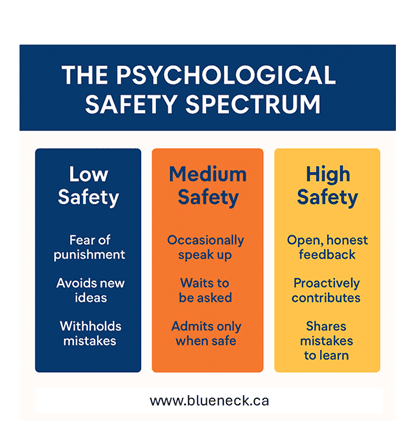When your team goes quiet, your business pays the price.

When’s the last time one of your team members challenged your idea?
Not out of disrespect, but out of curiosity. The purpose of doing something better is not “going along to get along.”
If your answer is “I can’t remember,” we need to discuss psychological safety.
Psychological safety is not a nice-to-have. This will change silent teams into high-performing teams, which is a core business strategy. And in blue-collar industries, where operational execution, safety, and teamwork are all important, establishing this type of culture is not only wise. It’s essential.
What Does Psychological Safety Mean?
Psychological safety is the belief that someone can speak up, contribute ideas, raise questions, admit errors, or question the status quo without fear of embarrassment, rejection, or retribution.
The term was coined by Harvard Business School professor Amy Edmondson and proved by Google’s Project Aristotle, where psychological safety was found to be the number one factor driving high-performing teams - not skills, not IQ, not experience, but safety.
So why does it matter so much?
Because when team members feel safe, they:
Ask questions that prevent costly mistakes Raise safety concerns without hesitation Offer suggestions that improve efficiency Collaborate more freely Hold themselves — and others — accountable
In other words, psychological safety boosts engagement, innovation, alignment, and resilience — the exact ingredients needed to drive business performance.
What Psychological Safety Is Not
Let’s bust a few myths.
🚫 It’s not “anything goes.”
Psychological safety thrives with structure. It’s about creating clear expectations and human interactions.
🚫 It’s not being “too nice.”
Safety isn’t about avoiding conflict—it’s about handling it with respect. Teams that feel safe disagree more, not less, because they trust each other.
🚫 It’s not just HR’s job.
It starts at the top. Leaders shape culture—whether they mean to or not.
Why Psychological Safety Matters for Teams
Let’s say you run a manufacturing company. A technician notices a recurring issue on the line, but they keep it to themselves because last time they spoke up, it went nowhere — or worse, they were brushed off publicly.
Now, that issue turns into a full-on equipment failure. Downtime skyrockets. Costs balloon. Your reputation takes a hit.
That’s what happens in low psychological safety environments.
In industries where precision and communication are critical — silence isn’t golden. It’s expensive.
Yet many business owners don’t realize the subtle ways their culture might be discouraging honest conversation. Here are a few red flags:
You’re the only one talking in meetings People don’t share mistakes unless directly asked Team members nod along without offering input There’s visible discomfort when giving feedback Ideas only flow from the top down
If any of that sounds familiar, you’re not alone. But you can change it.
The Business Case for Psychological Safety
Let’s put some numbers to this concept.
According to Forbes, employees who feel heard are 4.6x more likely to feel empowered to do their best work. Research by Deloitte shows that inclusive teams outperform their peers by 80% in team-based assessments. And as McKinsey explains in their explainer on psychological safety, teams with higher psychological safety experience stronger collaboration, more innovation, and better decision-making — key drivers of performance in any industry.
If you’re a leader trying to manage labor shortages, rising costs, and operational demands — psychological safety might just be your secret weapon.

5 Practical Steps
Create a Psychologically Safe Culture
Creating psychological safety isn’t about being soft. It’s about being clear, consistent, and human in how you lead.
Here’s how to start:
1. Model Curiosity, Not Certainty
Leaders don’t need all the answers — they need better questions.
Try this: Instead of saying, “We’re doing it this way,” ask, “What do you see that I might be missing?” This invites collaboration without threatening authority.
2. Reward Speaking Up — Especially When It’s Risky
When someone challenges an idea or admits a mistake, thank them. Publicly. This tells others it’s safe to do the same.
Example: A field technician points out a process flaw that could cause delays. Rather than brushing it off, you say, “Thanks for raising that. Let’s figure out how to fix it.” Boom — trust built.
3. Make Feedback Routine, Not Rare
Create a rhythm for feedback — daily check-ins, weekly debriefs, or monthly reviews. Keep it simple, consistent, and two-way.
Ask: “What’s one thing we could do better this week?” Or: “Is there anything I’ve done recently that made it harder to speak up?” This creates space for continuous improvement.
4. Fix Small Frustrations Fast
When small issues go unaddressed, they snowball into silence.
Try this: If someone says, “The new scheduling system’s confusing,” don’t say, “Deal with it.” Ask what’s confusing. Dig in. Improve it. Small fixes show your team that their input matters and encourage more of it.
5. Create Team Norms Together
Want a culture of openness? Build it together.
Consider: Having your team co-create a “Ways We Work” list with values like:
“We listen fully before responding.” “We ask questions instead of making assumptions.” “We give feedback to help each other grow.”

The Psychological Safety Spectrum
Here’s a simple graphic you could share at your next team meeting.
Where does your team land today?
Where do you want to be?
Real-World Example: A Shop Floor Turnaround
A fabrication shop with 35 employees was struggling with missed deadlines and high turnover. Work was getting done, but barely. In meetings, no one was speaking unless spoken to. Field mistakes were often covered up or blamed on others.
After interviewing the team, the owner uncovered a common theme: “We’re not listened to.” Supervisors rarely asked for feedback, and when they did, little changed.
Taking this feedback seriously, the owner — with coaching — worked to build more psychological safety into daily operations. They introduced a few simple changes:
- Weekly “voice of the team” huddles where feedback is now invited and acted upon.
- A new open-door policy where any employee can raise an idea or concern.
- Publicly recognizing people who speak up about challenges or process improvements.
Within several months:
- Employee satisfaction scores increased based on a pulse survey.
- Turnover began to drop, saving thousands in recruiting and training costs.
- On-time delivery improved, boosting client trust and referrals.
The shop floor doesn’t become perfect overnight. But by building trust through action, you can go from a culture of quiet compliance to one of confident contribution and the business will grow stronger because of it.
The takeaway? Listening is free. Ignoring people is expensive.

From Quiet Compliance to Confident Contribution
Psychological safety isn’t about being soft — it’s about being smart.
It’s what turns your team from muzzled to mighty, from hesitant to high-performing.
When leaders create environments where people feel heard, trusted, and valued, they don't just boost morale — they unlock higher performance, innovation, and loyalty.
Are you prepared to create a culture where your people thrive?
Visit www.blueneck.ca to learn more about our leadership coaching, strategy, and leadership development services — or contact us directly for a conversation that could change your business.
Simple changes. Big impact. One conversation away.

